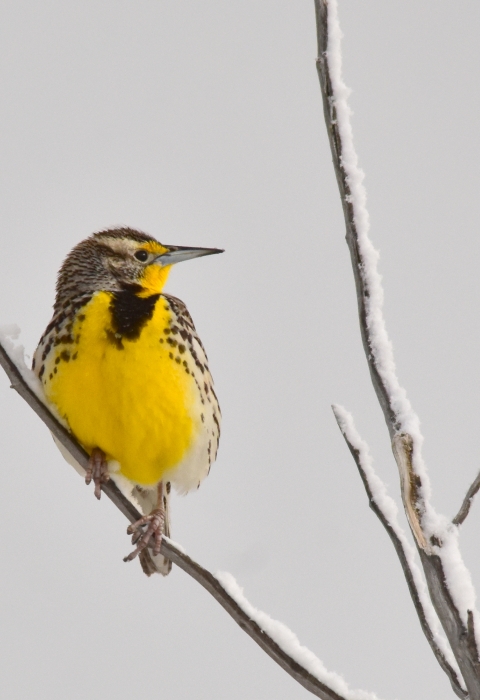It’s the peak of songbird migration in many parts of the country, and that’s probably loud and clear when you step outside in the morning. Both migratory and non-migratory birds sing in spring to impress would-be mates and mark their territories, filling the air with their earnest trills, chirps and whistles.
But you probably hear birds every day of the year without realizing it.
Have you ever been told you eat like a bird, praised for your eagle eye or reminded that the early bird catches the worm?
Maybe you slipped and fell on the ice this winter and hurt your coccyx — from the Greek word for cuckoo due to the bone’s resemblance to the eponymous bird’s beak.
Gardeners may be familiar with columbine, meaning dove-like plant; “hens and chicks,” a rosette-shaped succulent; and larkspur, a flower with long petals thought to resemble the talons of a meadowlark.
In Mexico, you might call a bowl of popcorn “las palomitas de maíz,” meaning, little pigeons of corn.
If you have a glass of merlot with your popcorn, you are introducing another bird to the flock. Merlot comes from the French “merle” for blackbird.
And whether or not you recognize the woeful coos of the mourning dove, you probably know what it sounds like when doves cry.
“Hope” is the thing with feathers
When you start looking and listening for birds in language, you’ll find them everywhere.
“We could fill an entire show with bird references,” said Martha Barnette, co-host of the public radio talk show “A Way with Words,” when I called in to ask about the prevalence of birds in language. She and her co-host Grant Barrett, a linguist and lexicographer, provided all the examples mentioned above.
My question was motivated by a realization. There are many good reasons to care about and conserve birds and their habitats. They play irreplaceable roles in nature — pollination, predation and seed dispersal, to name a few. And they drive a lucrative recreational industry. More than 96 million people in the U.S. watch birds, and wildlife watching generates more than $250 billion in economic impacts each year.
But maybe we should also celebrate the role birds play in shaping our language.
Through idioms, analogies, proverbs and more, they enliven what we say and how we say it, providing an endless source of semantic inspiration.
Barnette, who studied ancient Greek, Latin and Spanish, shared a favorite proverb en español: La fe es el pájaro que siente la luz cuando el alba aún está oscura.
Meaning, “Faith is the bird that feels the light while the dawn is still dark.”
“It’s the perfect metaphor for dark times,” she said. Birds start singing because they know the sun will rise eventually.
It made me think of a well-known poem in English, “’Hope’ is the thing with feathers” by Emily Dickinson. What could be more hopeful than a beautiful creature that flies and sings?
Vultures circling
When I asked if they saw any indication birds might disappear from language over time, given the growing disconnect with nature in our digital age, Barrett dismissed concerns. In the grand scheme of things, he said, our current era is just “a thin patina” in human history and culture. “The essential relationship between people and wildlife is eternal.”
A quick search of lyrics by one of today’s best-telling musicians, Taylor Swift, provided reassurance.
“Down in the park, honey, making a lark of the misery.”
“Carolina knows why for years I roam free as these birds.”
“See the vultures circling dark clouds.”
Even her last name is a type of bird.
But in the physical world, birds really are disappearing. Scientists estimate we have lost nearly 3 billion birds since 1970 in North America, which is roughly 1 out of every 4 birds.
The more we reflect on the myriad ways we benefit from birds — including through language — the more we will appreciate how much is at stake with their declines.
But we should heed the advice of a Russian proverb: Соловья баснями не кормят. Translation: you can't feed a nightingale with fables.
“It means empty words don’t get anything done,” Barnette explained.
Be the wind beneath their wings
The U.S. Fish and Wildlife Service works with partners across North America to study and conserve birds and their habitats. There are many ways you can help birds, too. Here are five ways to get involved:
- Take part in community science: Help scientists answer key questions about birds, such as arrival dates, abundance and departure dates of migratory birds, and report sightings of rare and common birds.
- Share the shore: Follow posted information at beaches to give shorebirds the space they need to forage, nest and raise their young.
- Prevent collisions: An estimated one billion birds die as a result of window collisions in North America each year, attracted either by lights at night or the reflection of sky and trees during the day. Use bird decals, window film and timers for lights to prevent collisions.
- Be a brew gooder: Look for shade-grown and bird-friendly coffees, which are produced on farms that provide critical shade-cover habitat for migratory and resident birds in tropical landscapes threatened by deforestation.
- Buy a Duck Stamp: Purchasing Federal Duck Stamps directly supports conservation of more wetland habitats that birds and other species depend upon.







